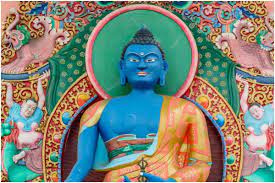

TYPE: The second dhyanibuddha or meditation buddha.
ORIGIN: Buddhist [India]
KNOWN PERIOD OF WORSHIP: Circa 500 BCE to present.
SYNONYMS: Vajrasana; Vajraheruka
CENTER(S) OF CULT: pan-Asiatic
ART REFERENCES: Metal and stone sculptures, paintings
LITERARY SOURCES: Sadhanamala and Tantric ritual texts.
INFORMATION: One of five mystic spiritual counterparts of a human buddha in Vajrayana Buddhism. A product of the Adibuddha who represents the branch of the cosmos concerned with consciousness. He originates from the blue mantra HUM and lives in the eastern paradise Abhirati. His Sakti is Locana and he is normally accompanied by two elephants. Aksobhya may also be a tutelary deity in Lamaism [Tibet] in which case his attributes are similar. See also Amitabha, Amoghasiddhi, Ratnasambhava, and Vairocana
Akshobhya (Sanskrit: Aksobhya, "Immovable One"; traditional Chinese: pinyin: Achùrúlái; Japanese pronunciation: Ashuku Nyorai) is one of the Five Wisdom Buddhas, a product of the Adibuddha, who represents consciousness as an aspect of reality. By convention he is located in the east of the Diamond Realm and is the lord of the Eastern Pure Land Abhirati ('The Joyous'). His consort is Lochana and he is normally accompanied by two elephants. His color is blue-black and his attributes include a bell, three robes, and staff, as well as a jewel, lotus, prayer wheel, and sword. He has several emanations.
COLOR: Blue
ATTRIBUTES: include bell, three monkish robes and staff, also jewel, lotus, prayer wheel and sword.
EMANATIONS: include Heruka, Manjusri, Vajrapani, and a large number of minor names.
TEXTUAL HISTORY AND DOCTRINE:
Akshobhya appears in the Aksobhyatathagatasyavyuha Sutra (Chinese: pinyin: Achùfó Guó Jing), which was translated during the second century CE and is among the oldest known Mahayana or Pure Land texts. According to the scripture, a monk wished to practice the Dharma in the eastern world of delight and made a vow not to harbor anger or malice towards any being until he achieved enlightenment. He duly proved "immovable" and when he succeeded, he became the buddha Akshobhya. Recently, newly discovered Gandhari texts from Pakistan in the Bajaur Collection have been found to contain fragments of an early Mahayana sutra mentioning Akshobhya. Preliminary dating through paleography suggests a late 1st century to early 2nd century CE provenance. More conclusive radiocarbon dating is under way. A preliminary report on these texts has been issued by Ingo Strauch, with a paper on Akshobhya texts published in 2010.
In the Surangama mantra ( Chinese :pinyin : Léngyán Zhòu ) taught in the Surangama sutra ( Chinese :pinyin : Léngyán Jing ), an especially influential dharani in the Chinese Chan tradition , Akshobhya is mentioned to be the host of the Vajra Division in the East, one of the five major divisions which controls the vast demon armies of the five directions.
Akshobhya is sometimes merged with Acala, whose name also means "immovable" in Sanskrit. Prior to the advent of Bhaisajyaguru, Akshobhya was the subject of a minor cult in Japan as a healing Buddha, though both are currently venerated within Shingon Buddhism.
ICONOGRAPHY:
Akshobhya is the embodiment of 'mirror knowledge' (Sanskrit: adarsa-jñana; refer Panchajnana). This may be described as a knowledge of what is real, and what is illusion, or a mere reflection of actual reality. The mirror may be likened to the mind itself. It is clear like the sky and empty, yet luminous. It holds all the images of space and time, yet it is untouched by them. Its brilliance illuminates the darkness of ignorance and its sharpness cuts through confusion. Akshobhya represents this eternal mind, and the Vajra family is similarly associated with it.
The Vajra family, is also associated with the element of water, hence the two colours of the Vajra being blue, like the depths of the ocean; or bright white, like sunlight reflecting off water. Even if the surface of the ocean is blown into crashing waves, the depths remain undisturbed, imperturbable. Although water may seem ethereal and weightless, in truth it is extremely heavy. Water flows into the lowest place and settles there. It carves through solid rock, but calmly, without violence. When frozen, it is hard, sharp, and clear like the intellect, but to reach its full potential, it must also be fluid and adaptable like a flowing river. These are all the essential qualities of Akshobhya.
Many wrathful, tantric beings are represented as blue in colour because they embody the transmuted energy of hatred and aggression into wisdom and enlightenment.